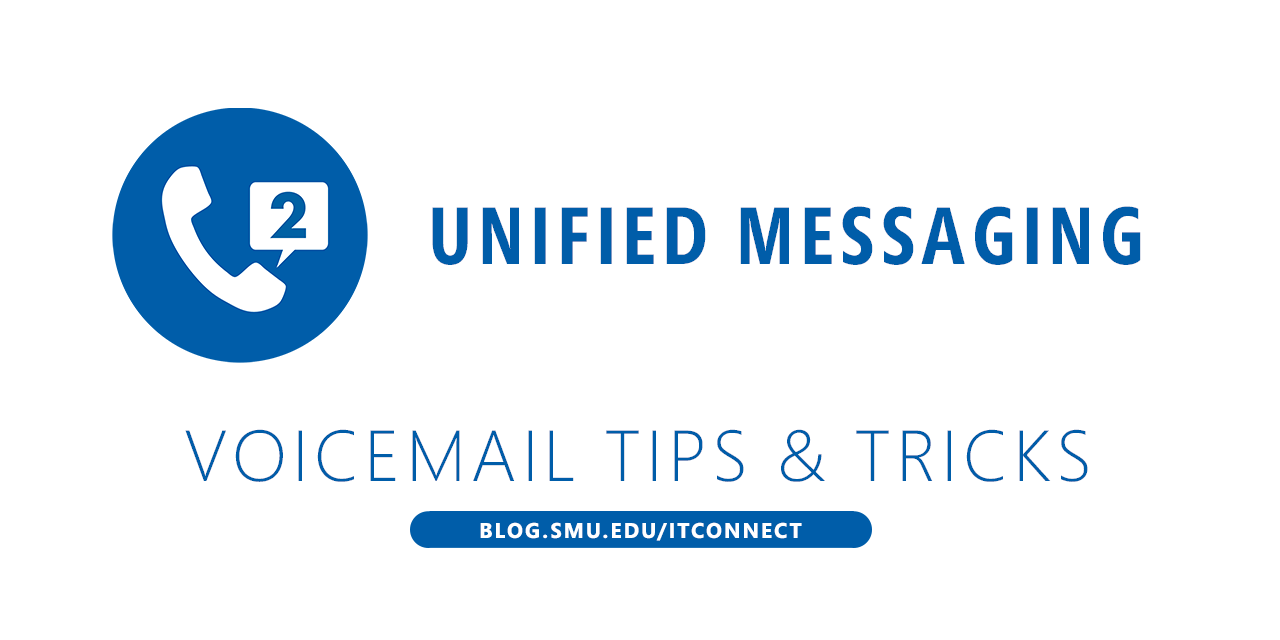 Although many SMU users appreciate the ability to receive missed call notifications and voice mail recordings and transcriptions via their email, several users have expressed a preference for checking voicemail “on the phone,” including those in public settings who enjoy the added security of listening to personal messages using a handset or mobile phone. Here is how to use both: Continue reading You Can Still Use Your Phone to Check Voicemail
Although many SMU users appreciate the ability to receive missed call notifications and voice mail recordings and transcriptions via their email, several users have expressed a preference for checking voicemail “on the phone,” including those in public settings who enjoy the added security of listening to personal messages using a handset or mobile phone. Here is how to use both: Continue reading You Can Still Use Your Phone to Check Voicemail
Tag: Unified Messaging
Unified Messaging: Your New Voicemail System
In this webinar, learn more about the new voicemail system. Discover all of the new features Microsoft Unified Messaging brings to SMU! View the webinar after the break. Continue reading Unified Messaging: Your New Voicemail System
How to remove voice mail transcriptions from Unified Messaging Voice Mail

The new campus voice mail service (Exchange Unified Messaging) has a feature which provides text transcriptions of voice mail messages to the Inbox by default. The accuracy of these text transcriptions may suffer for callers with accents, or poor quality calls (e..g, cell phone callers with bad reception).
 We expect the accuracy of these transcriptions to improve when we upgrade the system within the coming months. However, some users may wish to opt out of text transcriptions and check their voice mail by either playing the audio attachment or by dialing into the system at extension 88673. Here is how to disable the transcription feature:
We expect the accuracy of these transcriptions to improve when we upgrade the system within the coming months. However, some users may wish to opt out of text transcriptions and check their voice mail by either playing the audio attachment or by dialing into the system at extension 88673. Here is how to disable the transcription feature:
- Login to webmail.smu.edu. Click the gear icon, click Options, then click General, then click Voice Mail Preview.
-or-
Open Outlook, click File – Manage Voice Mail. - Under Voice Mail Preview, uncheck “Include preview text with voice messages I receive”.
- Click Save.
Updated 07/10/2017: Include updated instructions for the new system.
UM Voice Mail: Where is my PIN notification?

As we continue the roll out of our voice mail replacement solution (Microsoft Exchange Unified Messaging, or UM for short) to faculty and staff, a few users have reported that they have not received the PIN notification once their mailbox is set up for UM voice mail.
If you encounter this issue, the first place you should check is your Junk Email folder or Deleted Items. If you still can’t find your message, a rule in your Inbox might be preventing these messages from getting through.
- Go to webmail.smu.edu and log in to your email account.
- In the upper-right corner, click the gear icon, then click Options.
- On the left side, click Inbox and Sweep Rules to see your Inbox Rules.
- If you see a rule named “Microsoft Outlook” and you don’t know what it’s for, either disable or delete the rule.
- Next, select General – Voice Mail – Reset PIN, then click “Reset my voice mail PIN” in order to assign yourself a PIN. You can also contact the OIT Help Desk to have your PIN reset.
You should now receive your PIN notification message!
Updated 07/10/2017: Include updated instructions for the new system.
How to record a greeting for a secondary extension in Unified Messaging

Some SMU users have multiple extensions assigned to their personal mailbox for Unified Messaging Voice Mail. The secondary extension could be a department number or resource phone. By default, the same voicemail message will be played for all extensions assigned to a mailbox.
Here is how to record a unique greeting for a secondary extension:
To get started:
| In Microsoft Outlook: | In Webmail: |
|
|
To change the greeting:
- Under Call Answering Rules, click New Rule.
- Enter a name for the rule.
- Under Add conditions, select “If the caller dialed my phone extension…”, and select your secondary extension.
- Keep the default action, and click “Call the Play on Phone number to play or record a greeting for this call answering rule…”.
- Click Yes to save the call answering rule.
You will receive a call which will prompt you to leave a voice mail message. Be sure to include “press pound to leave a message”; this is a requirement for secondary extensions.
If you would like to switch your primary and secondary extensions, please email help@smu.edu to create a help desk ticket.

